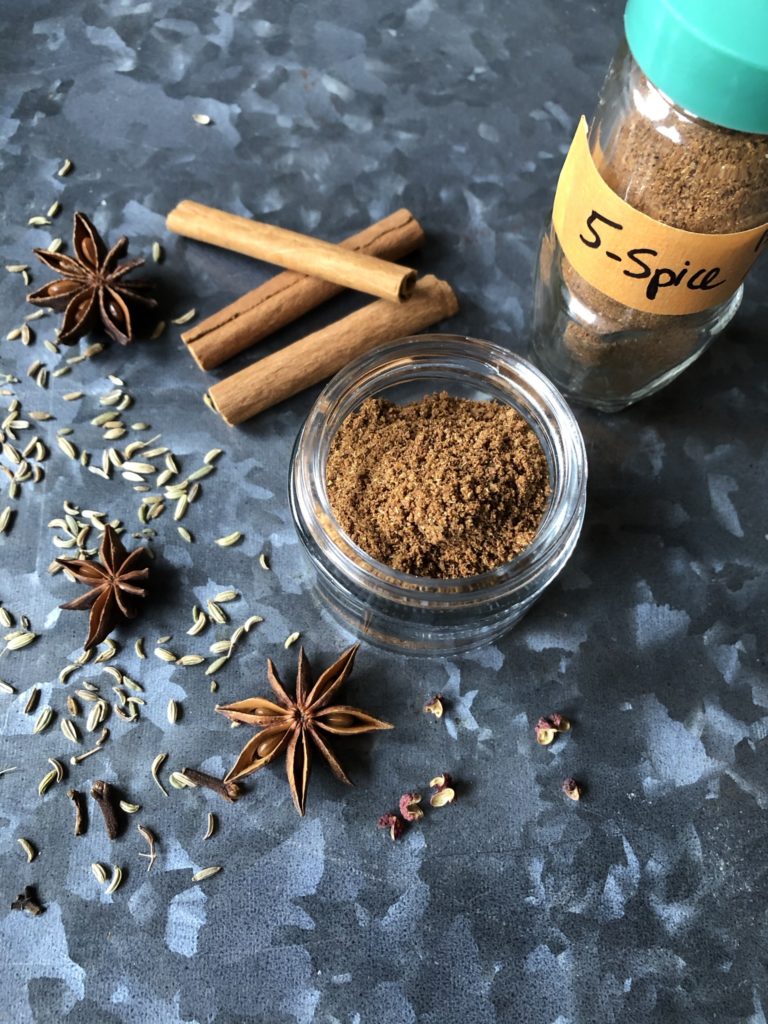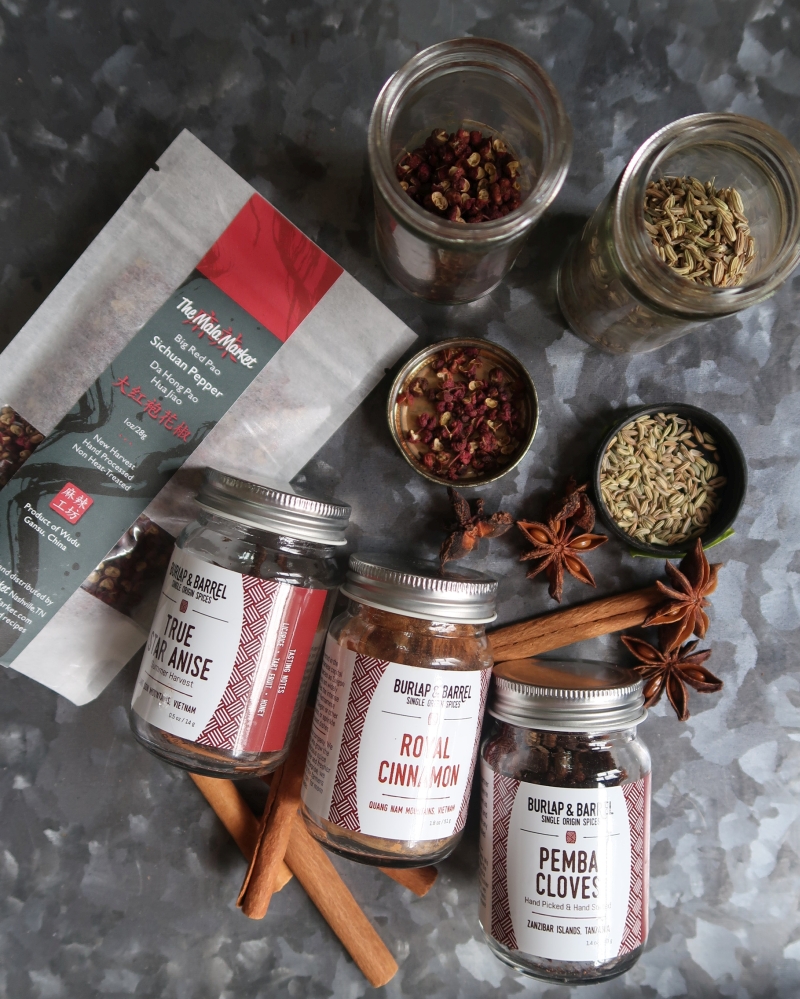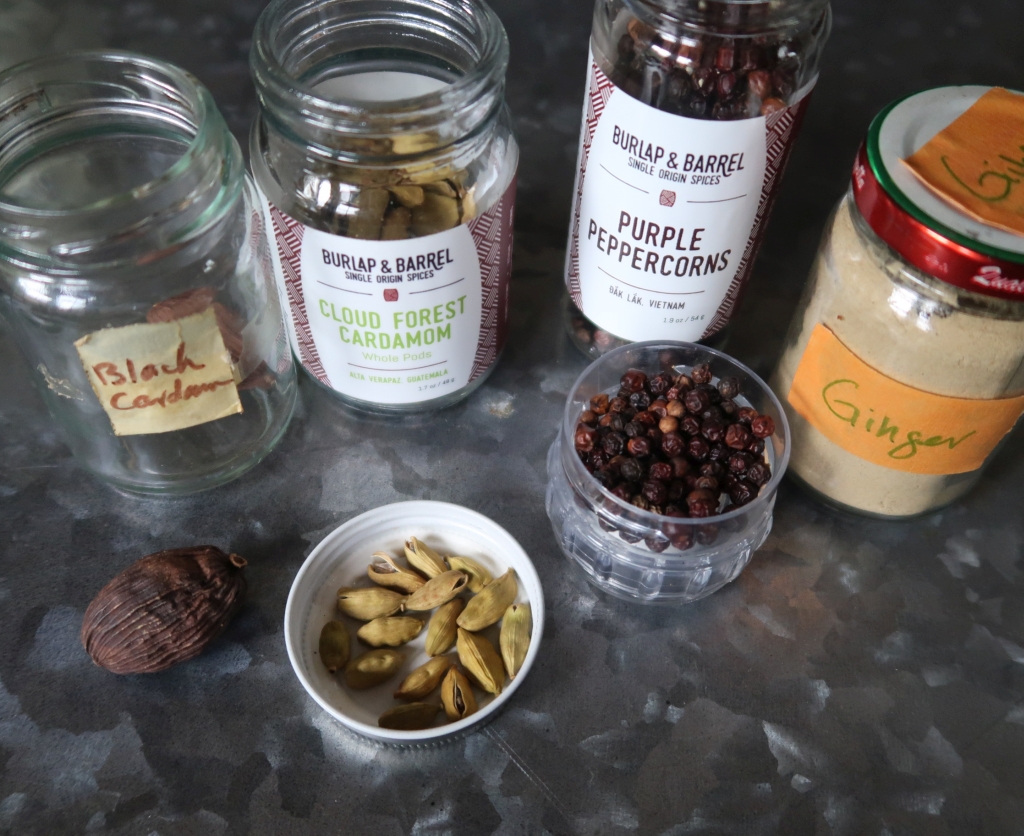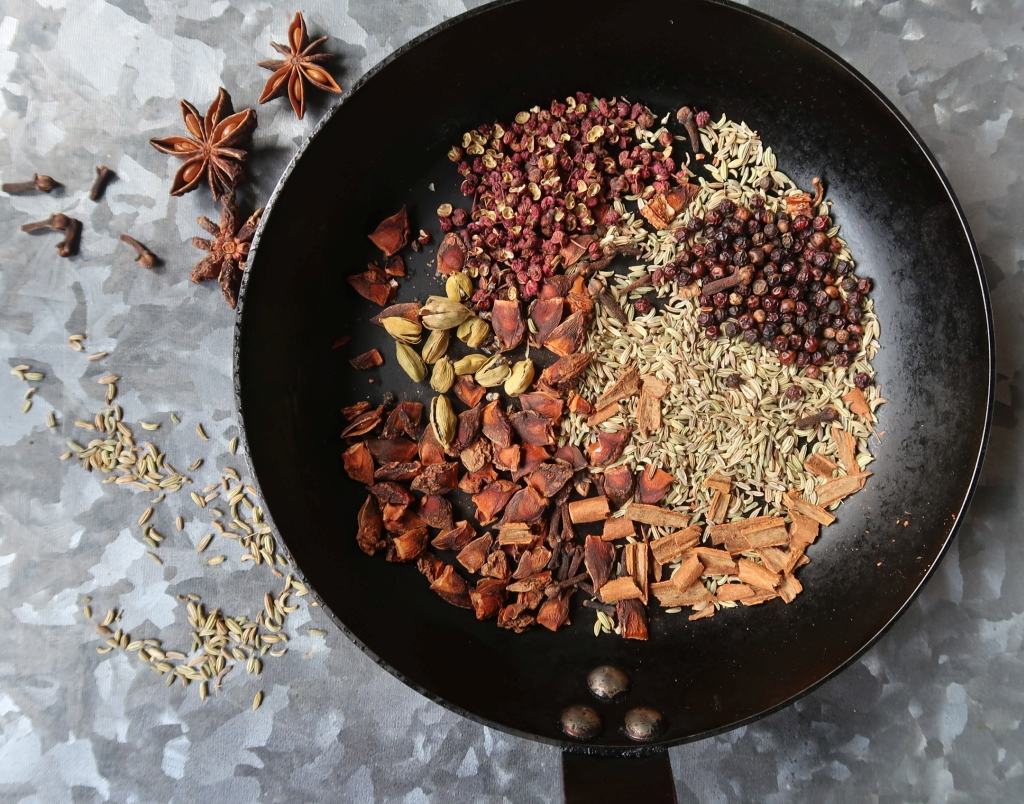What Is Five Spice Powder Made of

With all the fair-trade, single sourced, fancy-ish spices available these days, why isn't there a great Chinese five-spice powder? People write about and tackle dukkah, ras el hanout, and pumpkin spice blends but seldom do I see mention of homemade Chinese five-spice powder.
I regularly use the aromatic East Asian blend called wǔxiāng fěn in Mandarin and ngũ vị hương in Vietnamese. It's required for Cantonese char siu pork or chicken and Viet bò kho beef stew -- dishes on my regular rotation. I also use it for Viet-Chinese pork ribs and roast chicken (see the recipes for honey-glazed pork riblets and honey-hoisin roast chicken in Vietnamese Food Any Day). Sadly, the blends that I was buying from Taiwan and then Spicely Organics have gotten harder to source locally. For that reason, I took the route to homemade Chinese five-spice powder.
It's been about twenty years since I made my own blend, despite having blended spices for garam masala many times. Why didn't I give the same attention to the iconic Chinese blend? Maybe because it's just not elevated enough. I've read articles in which there are elegant arguments for well-crafted Japanese shimichi togarashi and North African berbere plus how there's no such thing as an Indian "curry" blend. Where's the Chinese five-spice discussion?
What is Chinese Five-Spice Powder
Books on my shelves -- from academic and anthropological works like K.C. Chang's Food in Chinese Culture to trusty cookbooks like Kiam Lam Kho's Phoenix Claws and Jade Trees, have little to say on the fragrant spice blend. I found Chinese five-spice powder recipes in Barbara Tropp's China Moon, Carolyn Phillips' encyclopedic All Under Heaven, and Lior Lev Sercarz's The Spice Companion, but not much depth. If you have leads, please let me know.
Most published mentions focus on the number five, even though you do not have to include five spices. In general, Chinese five-spice powder involves blending star anise, cassia (cinnamon), cloves, fennel and Sichuan peppercorn. You could describe those spices as offering sweet, savory, zingy, bitter, earthy notes.

But the number five carries a lot of weight. It hits on the Chinese notion of harmony and balance. For example, Chang wrote in his book:
The formula for discussing each food is, first, to indicate to which of the five flavors it belongs. Those are: sweet, sour, bitter, pungent, and salty; related respectively to the five agents or five elements, earth, wood, fire, metal and water. Although not made explicit and this work, one medical theory holds that the flavors relate to the five viscera, through their corresponding agent: the stomach (earth), the liver (wood), the heart (fire), the lungs (metal) and the kidney (water).
If you'd like more information, research Chinese Traditional Medicine's five-element theory. Perhaps the spices blended were selected for medicinal purposes. Tropp wrote that Chinese five-spice powder may also have been used to mask or preserve food flavors. Whatever its original purpose, Chinese five-spice powder still plays a significant role in many dishes. I've seen it used to add a Chinese-ish note in fusion-style dishes, too.
Creating Your Own Chinese Five-Spice Blend
Beyond the foundational five spices, you may add different kinds of cardamom; I favor sweet and menthol green pods or smoky menthol black cardamom. Black peppercorns are also a potential addition, as is ground ginger.

Dried tangerine (Mandarin orange) peel, licorice, and galangal may also be employed in Chinese five-spice powder. In other words, as Kian Lam Kho notes in his beautifully written book, you can get creative. I've seen chamomile, coriander and cumin figure into the mix!
For the blend I created this time, I focused on eight spices and included wonderful cassia, star anise and peppercorns cultivated in Vietnam. (Note that many of the spices for Chinese five-spice are also used for brewing pho broth; see this pho spice primer.) The black cardamom I purchased for making Hanoi-style pho and a pho spice blend may have come from Vietnam too. (Not familiar with black cardamom? Check out the National Geographic story on trekking for the spice.)
I tinkered with the blend to include two more spices, but I have to admit to you that things got a bit muddled. Eight seemed enough for me this time. The cool thing about DIY Chinese five-spice powder is you can experiment with it. You can start with the basic five spices, and if you don't like it, add more spices and re-blend!
Sourcing Spices
My spices come from Asian markets, spice shops, travels near and far, health food store bulk bins, and even Costco. As of late, I've really enjoyed single source spices like Sichuan peppercorns from Mala Market, saffron from Rumi, turmeric from Diaspora, Co., and the knockout selection at Burlap and Barrel (search for "Vietnam" for a treat). Those small businesses build special partnerships overseas to source excellent spices.

Spices aren't cheap, but if you get good ones, your food will shine. You don't have to use fancy, super special spices all the time. My homemade Chinese five-spice powder includes stuff from unnamed sources purchased at a Chinese market and hippie health food market. But take the extra step to find one or two vibrant spices and boy, you'll have an elegant blend at your fingertips for all kinds of kitchen adventures.
In using the homemade five-spice powder in dishes, I noticed that they had extra sparkle. That may have been because of the freshly ground spices and the blend itself, but gosh, it took little effort to add zip to my Asian food. I don't think I'll go back to buying the spice blend again.
Chinese Five-Spice Powder
This recipe makes about 1/2 cup -- plenty to gift one or two friends. Halve it for single household use.
- 2 tablespoons fennel seed
- 8 star anise, broken into individual petals
- 2 tablespoons Sichuan peppercorns
- 1 cinnamon/cassia stick, broken into small pieces (use your fingers)
- 1/2 teaspoon whole cloves
Optional additions (choose all, some or none)
- 12 green cardamom pods or 1 medium Chinese black cardamom, gently crushed open with the broad side of a knife of meat mallet (discard the tough black skin of the black cardamom; keep the green skin on the other kind)
- 1 tablespoon black peppercorns
- 1/4 teaspoon ground ginger
-
Toast the spices. Combine the whole spices (everything but the ginger!) in a small skillet. Set over medium-low heat and cook, stirring frequently, for about 5 minutes, until very fragrant, popping a tiny bit; some of the fennel seeds should be lightly browned. At that point, pull the skillet off the heat and pour the spices into a bowl to cool. Stir in any ground spices you may be using so may commingle well with the warm, toasted spices.
-
Cool, grind, and store. Let the spices cool to room temperature before grinding in 2 or 3 batches in a clean electric grinder dedicated to spices or a spice grinder.
-
When done, clean the grinder by whirling up a tablespoon of raw rice, and discarding it. Store the Chinese five-spice powder in a jar for up to a year. You may push it to 2 years but if it's faded in flavor and fragrance, definitely make a new batch.
What Is Five Spice Powder Made of
Source: https://www.vietworldkitchen.com/blog/2020/12/homemade-chinese-five-spice-powder.html
0 Response to "What Is Five Spice Powder Made of"
Post a Comment